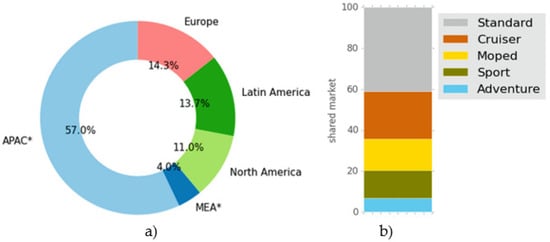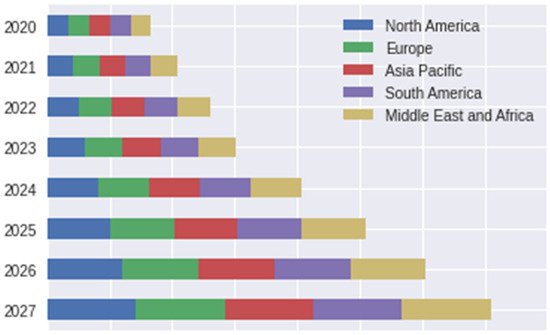In many cities, urbanization has led to a rapid increase in the demand for mobility. Most of this new demand has been satisfied by the individual private transport industry, within which motorcycles have an important share: around 30% of the vehicles in the world are motorcycles. Thus, the motorcycle market has experienced an upward trend, especially in developing countries. That uncontrolled growth brings along mobility, accidents, and environment-related issues that concern policy-makers. Research trends regarding this matter evidence that greenhouse gas emissions, sustainability, environmental impact, and developing countries are the topics of greater interest for researchers. In addition, taking into account the needs of modern cities, sustainable modes of transport such as electric and shared mobility are compulsory as a priority on governments' agendas.
1. Introduction
Motorcycles, also known as motorbikes or bikes, are two-wheelers primarily driven by an internal combustion engine. Nevertheless, nowadays, consumers are also opting for electric motorcycles. The global sales of motorcycles have been similar to those of cars since 2007, reaching 70 million units sold per year [
2]. The global motorcycle market was estimated to be worth USD 115,720 Mn in 2018 [
3].
Figure 1 presents the global motorcycle market share by region (left) and by motorcycle type (right) in 2020.
Figure 1. (
a) Global motorcycle market share by region. (
b) Global motorcycle market share by type. * APAC: Asia-Pacific. MEA: Middle East and Africa. Data taken and adapted from [
4].
2. Motorcycle Market
Asia-Pacific is the region with the largest number of motorcycles in the world, accounting for a market share of 57%. In this region, 60% of the vehicles are motorcycles, and it reports the highest rate of motorcycles per inhabitant (with Taiwan as the leader: one motorcycle per every 1.6 people) [
5]. Europe has the second largest market share: 14.3%.
The motorcycle market can also be segmented by motorcycle type. Standard motorcycles represent 40.1% of the value of the market; cruiser, moped, and sport are 23.3%, 15.3%, and 13.6%, respectively; and adventure is 6.8%.
Although the coronavirus disease of 2019 (COVID-19) pandemic had a negative impact on the global motorcycle industry (revenue in the motorcycle market is projected to reach USD 108,833 Mn in 2020), the motorcycle market is anticipated to expand 1.1 times in terms of value during the 2020–2030 period after the resumption of operations. This means that this market is poised to grow at a Compound Annual Growth Rate (CAGR) of 3.6% [
4].
The current global market is dominated by internal combustion engine motorcycles. However, growing consumer awareness of climate change, a rising population (resulting in traffic congestion in several countries), the low maintenance cost of electric mobility technology, and tax incentives for environmentally friendly vehicles are boosting the sales of electric motorcycles. In 2020, 861 thousand electric units were sold worldwide [
6]. Although it can be considered a low number (because it represents less than 1.5% of the sales of all kinds of motorcycles during the same year [
7]), the electric motorcycle market is expected to grow at a CAGR between 7.4% [
8] and 31.8% [
6] from 2020 to 2027.
Figure 2 presents a forecast of the global electric motorcycle market by region for the 2020–2027 period. The market size is similar in all the regions, which can be due to the small size of the current market and makes granular forecasting a hard task.
Figure 2. Forecast for global electric motorcycle market. Data taken from [
8].
The growth of the motorcycle industry has been driven by the increasing middle-class population worldwide, which, in turn, has led to a higher demand for affordable means of transport [
5,
9]. These two-wheelers are a low-cost and versatile mobility alternative when compared to the costs and deficiencies of the public transport systems in terms of coverage, frequency, and comfort [
3].
Motorcycles have been studied from different perspectives. For instance, some authors have investigated the factors that influence the purchase of these two-wheelers in recent years [
5,
10,
11,
12,
13,
14,
15,
16,
17,
18,
19,
20]. Likewise, the literature in this field has reported some environmental concerns regarding their use. From certain points of view, motorcycles are more sustainable than cars mainly because they require less parking space and fewer financial resources and pollute less than conventional cars with low occupancy [
21].
Motorcycle-dominated cities are reported to have a more stable traffic flow and higher road capacity utilization compared to those with an equal number of four- and two-wheelers [
5]. However, motorized personal mobility vehicles produce several harmful effects on the environment due to the predominant use of fossil fuels and the dependence on oil [
22]. The transport sector is estimated to account for 24% of direct CO
2 emissions from fuel combustion [
23]. Motorcycles are thus often ignored in the new discourses on sustainable mobility, as they are regarded as undesirable for reasons of pollution, noise, road safety, and driving behavior [
24]. Motorcycle drivers and riders have more accidents than car passengers. According to Cordellieri et al. [
25], this is because motorcyclists are more prone to violate traffic rules than car drivers. Furthermore, they are less concerned about the risk of a road crash. As a result of their riskier riding behavior, the probability of accidents increases [
26,
27,
28]. In other studies [
29], it has been concluded that there is a strong relationship between driving violation behaviors and risk perception as predictors of motorbike crashes. Risk factors such as age and gender are also of interest for researchers. Several pieces of research [
30,
31,
32] have concluded that the crashes and fatalities suffered by male motorcyclists are higher and more severe than those of women, with the young drivers prone to have more accidents. Overall, research on causality and the severity of traffic accidents holds a dominant position in research trends about motorcycle accidents [
33].
Some studies have included the motorcycle industry in the analysis of other related problems (mainly environmental ones). For example, Hsieh et al. [
34] explored the changes in air pollution in Taiwan similarly to how Trappey et al. did [
35]. Peraphan et al. [
21] found that the use of motorcycles can affect the sustainable development of territories unless parking policies are implemented, which is in line with the results of Cheng et al. [
36]. In many countries, sidewalks are used as parking lots by motorcyclists, violating parking controls and affecting pedestrian flows [
37]. According to Thanh et al. [
38], this occurs mainly in business districts due to the size of motorcycles, parking prices, and walking distance from public transportation.
From a decision-making perspective, Yang and Chen [
39] modeled users’ choice of a means of transport taking into account its cost, travel time, and comfort. A new type of transport is ridesharing. Motorcycle ridesharing has emerged in recent years as a way to contribute to more sustainable mobility, especially using electric vehicles. Boken et al. [
40] concluded that, as a sustainable solution, ridesharing is a complement rather than a replacement for existing private car use. This is consistent with the results of Ampudia-Renuncio et al. [
41] regarding electric free-floating car sharing, who found that most trips occur in high-income and low-population density areas, where there is enough on-street parking available and connectivity to public transport. Other studies [
42,
43] also emphasize the role of millennials in ridesharing growth, identifying young men with high education levels, high income, and access to smartphones as the target market.
This entry is adapted from the peer-reviewed paper 10.3390/su131910813


